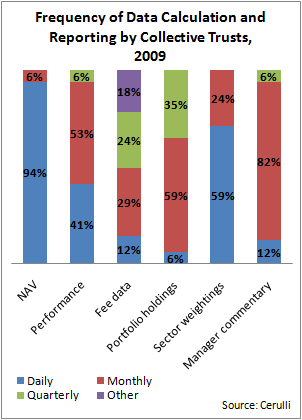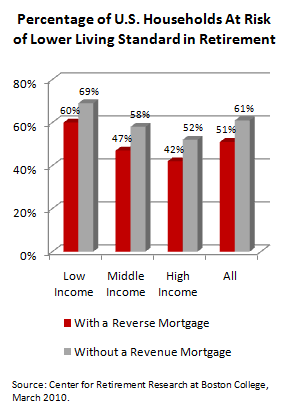
In a conference room in the old American Lithograph Building on Park Avenue in Manhattan recently, 15 female New Yorkers listened intently to a fellow New Yorker talk to them in New York-ese about how to manage their 401(k) accounts better.
The women, all employees of Landor Associates, a creative firm that manages brands for firms like Citigroup, Federal Express and Pepsico, ranged in age from 25 to 60. The instructor was Tony Truino, an energetic, nattily dressed MetLife advisor with a fast, in-your-face-but-in-a-nice-way Brooklyn patter that suited this audience to a tee.
“The rule of 25… has anybody heard of it?” Truino asked. “It’s a quick way to calculate how big of a nest egg you’ll need to retire on.” If you spend one twenty-fifth of your savings, or 4% per year, he explained, “Statistically, you won’t run out of money. But what if you spend $100,000 on health care on the first two years? I wouldn’t use the rule of 25. It’s close, but it’s not absolute.”
The concepts rained down in bunches, and weren’t easy to absorb. “My head hurts already,” remarked one of the participants. “Where’s the roulette table?” joked another, perhaps imagining a simpler way to gamble.
And so it went for almost two hours, as Truino and accountant George Gerhard, his MetLife tag-team partner, clicked through PowerPoint slides on topics like the differences between stocks and bonds (“ownership versus loaner-ship”), the security of T-bonds (“the government will always print enough money to pay you back”) and so forth.
Advertisement
The women remained silent, but focused. This was serious stuff.
The seminar at Landor Associates in February was just one of dozens of similar brown-baggers conducted by MetLife advisors under the insurer’s Retirewise investment education program for 401(k) participants.
The programs, which generally consist of four two-hour mid-day sessions, have been conducted at companies all over the U.S. The subject matter ranges from the basics of investing to the complexities of retirement income planning. MetLife charges neither the participants nor the plan sponsors a fee.
Post-Crisis, people are waking up to Americans’ their overall lack of preparedness for retirement and the shortage of unbiased information for 401(k) participants about converting savings to income. Retirewise helps answers that need.
What’s noteworthy about the program is that MetLife conducts the seminars at companies where another company—like Fidelity Investments, for instance—is the 401(k) plan provider. MetLife will typically also have a relationship with the plan sponsor, perhaps the dental insurance provider.
Retirewise is therefore something of a Trojan Horse. It gives MetLife a chance to promote its brand on its competitors’ turf. Indeed, its advisors aren’t shy about offering one-on-one consultations to seminar participants when the program ends. The consultations frequently lead to rollovers to MetLife when the employees change jobs or retire.
The campaign is also noteworthy in light of the recent announcement of the formation of the Defined Contribution Institutional Investment Association, one of whose stated goals is to foster the retention of participant assets in their plans (or in “deemed IRAs” in the plan) even after they retire. If anything, the battle for participant assets is accelerating.
 The program’s genesis
The program’s genesis
MetLife advisors have been conducting onsite education sessions for several years. But the roots of Retirewise in its current form go back to 2006, said Jeff Tulloch, a MetLife national sales director and manager of the insurer’s Individual Business Liaison Group, which includes Retirewise.
“It started with our CEO, Rob Henrikson, who comes out of the retirement business,” Tulloch said. “He knows we are facing a situation in America where it’s tough for a lot of people, where they’re responsible for their own retirement. So he asked us, ‘How do we leverage what we already do and apply it to what’s going in the market.’
“We looked at two of our U.S. businesses, the institutional business, which has 60,000 corporate customers, including 90 of the Fortune 100 companies, and our retail side, where we have 8,000 to 10,000 financial advisors. We started to think about leveraging those two—the customer relationships and the retail space.”
The Retirewise instructors or “specialists” include some of MetLife’s top producers. “We took a small subset of advisors who concentrate on retirement and are part of the retail field force, and we trained them as Retirewise specialists. It’s about 250 people, a small elite group whose members meet certain high-level criteria.”
A curriculum has gradually evolved over time. “We saw the lack of a comprehensive financial education program. We said, let’s incorporate things like investment principles and risk and get people thinking about their governmental benefits. There was no specific direction in terms of product or approach,” Tulloch said. MetLife does try to match the instructors with the audience, so it was no coincidence that at Landor, both the instructors and the audience were New Yorkers.
The program consists of four seminars. The first is devoted to the most basic issues: the importance of starting early to save for retirement, the principle of compounding and the Rule of 72, the impact of inflation, taxes, and fees on accumulation, the differences between various tax-deferred accounts, and so forth.
In the second seminar, the advisors describe the building blocks of a portfolio, including stocks, bonds, mutual funds and annuities. (MetLife is a leading seller of variable annuities with living benefits.) Concepts like asset allocation, diversification, and dollar cost averaging are also covered.
The third part of the program delves specifically into the transition from work to retirement. It covers payout options from defined benefit and defined contribution plans, the merits of income annuities, and the maximization of Social Security benefits. The fourth and final seminar involves aging, estate planning and insurance questions.
“We settled on a four-part program, with two hours in each part,” Tulloch told RIJ. “At the beginning, we wondered, will employees go for that? Eight hours is a long time, and you have prep work and homework on top of that. Our conclusion was, this is a lot of information to cover and even eight hours isn’t enough to do it right. So part of the message of the program is, this is just a launching pad for your financial education.”
Post-seminar consultations
So far, MetLife has conducted about a thousand Retirewise programs at about 500 different companies, reaching about 25,000 participants. People of all ages and income levels attend the voluntary sessions. The average age is about 45. An estimated 40% of the participants, MetLife has found, regard their employer-sponsored plans as the foundation of their retirement security.
Northeast Utilities, a power company in southern New England, has been the site of 25 to 30 different MetLife 401(k) education seminars over the past four or five years. The company employs 6,000 workers at four electric utilities in Connecticut, Massachusetts and New Hampshire.
Keith Coakley, the firm’s Director of Compensation and Benefits, said that NU first hosted a MetLife education program in 2004, when it invited advisors from Barnum Financial Group, an arm of MetLife, to counsel employees during NU’s transition from a defined benefit to a defined contribution pension plan. MetLife was (and is) a provider of home and auto insurance to NU employees.
Fidelity Investments is NU’s 401(k) provider. The Boston-based fund giant has offered to send its own investment counselors to NU, along with the printed education materials that it regularly sends out to its plan sponsors and participants. But NU was happy with MetLife and wanted to keep things simple.
“We don’t bring them both in,” Coakley told RIJ. “We once had a situation where we had two entities offering advice here. We found that it was a little confusing and even a little overwhelming for employees. So we decided to have one onsite presence. Employees can go to the nearby Fidelity office for advice if they want to, and Fidelity is always good over the phone.
“Prior to MetLife we had three different firms who were provided training, and it took a lot of effort to select the ones who didn’t sell so vigorously that the employees felt they were getting a sales pitch,” he added. The employees didn’t feel pressured by MetLife, and NU lost no staff time. “MetLife does all the meeting planning. We do almost nothing.”
Sober assessment
MetLife may use the soft-sell approach, but it does sell. Tulloch estimates that as many as half of the seminar attendees ask for a one-on-one consultation with an advisor after the program ends. Those meetings may or may not lead to ongoing professional relationships. But MetLife has found that the program also helps the plan provider.
“We wondered, how will this play with 401(k) providers? Would employers see how our program and the providers could work together? We found that the 401(k) providers benefit from what we’re doing,” he said.
“I was at a debriefing with an employer in California a year ago, and the human resource manager commented that after the seminar they’d seen an uptick in the contributions,” he added. “The specialists talk about increasing participant savings rates by one percent or so.”
While they’re heartened by the success of Retirewise, the program has brought MetLife officials to a sobering assessment of Americans as retirement savers.
“There’s been a verification in my own mind that we are a nation of procrastinators and spenders, who are concerned about retirement but don’t know where to start,” Tulloch added. “Employees tell us, ‘I know the basics of investing, but I don’t know how to pull it all together.’”
As MetLife spokesman Pat Connor put it, “We’ve learned that people don’t think about the retirement issue very much.”
© 2010 RIJ Publishing. All rights reserved.


 “Because [CTFs] are bank-registered products, you have an external fiduciary joining the plan sponsor,” he added. “Plan sponsors like that. If the asset manager is using a ‘40 Act’ [i.e., Securities Act of 1940] mutual fund format, there’s no co-fiduciary. From what we’ve heard, that makes the CTF an easier sell. We’ve also heard that Taft-Hartley plans [multi- employer union-sponsored DC plans] are more comfortable with CTFs.”
“Because [CTFs] are bank-registered products, you have an external fiduciary joining the plan sponsor,” he added. “Plan sponsors like that. If the asset manager is using a ‘40 Act’ [i.e., Securities Act of 1940] mutual fund format, there’s no co-fiduciary. From what we’ve heard, that makes the CTF an easier sell. We’ve also heard that Taft-Hartley plans [multi- employer union-sponsored DC plans] are more comfortable with CTFs.” 
 Retirees can generate funds from home equity by downsizing, or by borrowing against their home’s equity value. The reverse mortgage is a product specifically designed for retirees who wish to stay in their home and have access to its equity.
Retirees can generate funds from home equity by downsizing, or by borrowing against their home’s equity value. The reverse mortgage is a product specifically designed for retirees who wish to stay in their home and have access to its equity.









 The program’s genesis
The program’s genesis 